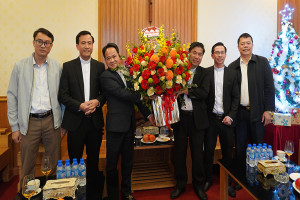
Hieu Nghia Ta Lon Buddhism is an indigenous religious-mixed sect in Vietnam founded by Master Nguyễn Ngọc An in 1915 in the country’s Southwestern province of Kien Giang.
For the name of the religious sect, Ta Lon is the name of a sacred mountain in the Vietnam Southwest where many founding masters believed to have made spiritual retreats and attained enlightenment. Hieu Nghia, meaning Familial Piety – Gratitude, is the core teaching of the faith for improve oneself.
Similar to other indigenous religious sects founded earlier in the Vietnam South, such as Buu Son Ky Huong, Hoa Hao and Tu An Hieu Nghia groups, Hieu Nghia Ta Lon Buddhist sect takes the guiding principle of "Improve Oneself - Study Buddhism – Repay Four Debts of Gratitude" as the religious motto. The Buddha’s dharma, practices for “Improve Oneself” and virtues of Avalokitesvara Bodhisattva are key features of Hieu Nghia Ta Lon Buddhist sect, which show a harmonious influence of Buddhism, Confucianism and Taoism that have taken roots in Vietnam for a long time.
As a distinctive characteristic of Buddhist-influenced indigenous sects in Vietnam, Four debts of gratitude to be repaid emphasized by Hieu Nghia Ta Lon Buddhism include the debt of gratitude to the parents and ancestors, the debt of gratitude to the home country, the debt of gratitude to the Buddhist Three Treasures, and the debt of gratitude to all fellow countrymen and mankind.
For religious canon laws, Hieu Nghia Ta Lon Buddhism issued 38 rules, including 20 prohibitions which generally aim to ensure the veneration for the Buddha, Avalokitesvara Bodhisattva, God of Heaven, God of Earth, Gods of Water, Fire and Earth Kingdoms, and Ancestors, Teachers, the parents, etc.
Daily worshipping rites of Hieu Nghia Ta Lon Buddhism are performed four times at the temple, and two times at followers’ home.
The religious symbol of Hieu Nghia Ta Lon Buddhism is the eight-petal lotus flower with three petals above five petals at the lower base.
The worshipping symbol of Hieu Nghia Ta Lon Buddhism is a sheet of red cloth symbolizing the Buddhist western direction, Saint and Deity, as well as essential elements in physical realm and “Familial Piety, Loyalty, Preservation, Gratitude”.
The single most important feast of Hieu Nghia Ta Lon Buddhism is on the 15th day of the 7th lunar month, it is the founding Day of the religious sect. There are also four religious festivals held annually at the worshipping establishments of Hieu Nghia Ta Lon Buddhism, with times corresponding to the 1st, 4th and 10th lunar months and worshipping rites dedicated to Buddhist figures and the founder of the religious sect.
Currently Hieu Nghia Ta Lon Buddhism has 6,500 followers with eight worshipping establishments, mainly concentrating in Southern provinces of An Giang, Dong Thap, Kien Giang and Can Tho city.
In the religious hierarchy of Hieu Nghia Ta Lon Buddhism, there are only two rankings, namely deacons and followers. Deacons of the religious sect are those nominated based on their spiritual advancement and prestige amongst religious groups, and often assigned to take care of the worshipping places and guide religious practices of followers.
Hieu Nghia Ta Lon Buddhist sect was granted the certificate of registration for operation of the organization by the provincial committee for religious affairs in Kien Giang on September 22, 2016. Its headquarters is based in An Binh Original Temple located in Kien Giang province’s Kien Luong town.
Tri An




